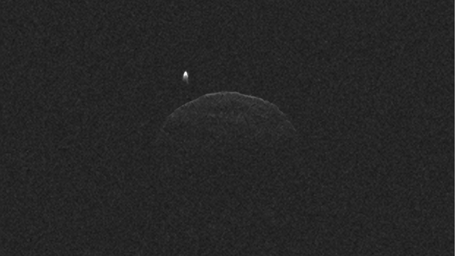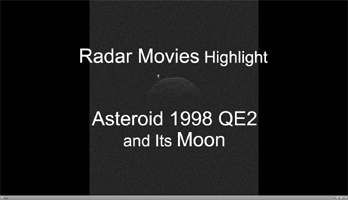
|
Radar Movies Highlight Asteroid 1998 QE2 and Its Moon
- Click the image above for a larger view
 Movie Download Options
Movie Download Options- Full-Res JPEG (1920 x 1080) (107.1 kB)
- Full-Res TIFF (1920 x 1080) (2.1 MB)
Caption:

Click on the image for the animation
This radar imagery of asteroid 1998 QE2 and its moon was generated from data collected by NASA's 230-foot-wide (70-meter) Deep Space Network antenna at Goldstone, Calif., on June 1, 2013. Each of the 55 individual images used in the movie required about five minutes of data collection by the Goldstone radar. At the time of the observations, asteroid 1998 QE2 was about 3.75 million miles (6 million kilometers) from Earth. The resolution is about 125 feet (38 meters) per pixel.
The data indicate the main, or primary body, is approximately 1.9 miles (3 kilometers) in diameter and has a rotation period of about five hours. The asteroid's satellite, or moon, is approximately 2,000 feet (600 meters) wide, has an elongated appearance, and completes a revolution around its host body about once every 32 hours. At any point during its orbit, the maximum distance between the primary body and moon is about 4 miles (6.4 kilometers). Similar to our moon, which always points the same "face" at Earth, the asteroid's satellite appears to always show the same portion of its surface to the primary asteroid. This is called "synchronous rotation."
Background Info:
More information about asteroids and near-Earth objects is available at: http://neo.jpl.nasa.gov/ , http://www.jpl.nasa.gov/asteroidwatch .
More information about asteroid radar research is at: http://echo.jpl.nasa.gov/ .
Cataloging Keywords:
| Name | Value | Additional Values |
|---|---|---|
| Target | 1998 QE2 | |
| System | Near Earth Objects | |
| Target Type | Asteroid | |
| Mission | Deep Space Network (DSN) | |
| Instrument Host | Goldstone Deep Space Communications Complex (GDSCC) | |
| Host Type | Ground-Based Observatory | |
| Instrument | Goldstone Solar System Radar | |
| Detector | ||
| Extra Keywords | Grayscale, Moon, Movie, Radar, Radio, Rotation | |
| Acquisition Date | ||
| Release Date | 2013-06-06 | |
| Date in Caption | 2013-06-01 | |
| Image Credit | NASA/JPL-Caltech/GSSR | |
| Source | photojournal.jpl.nasa.gov/catalog/PIA17235 | |
| Identifier | PIA17235 | |
